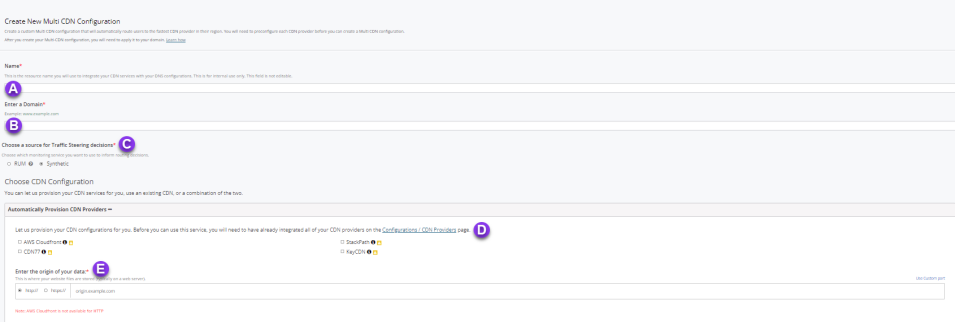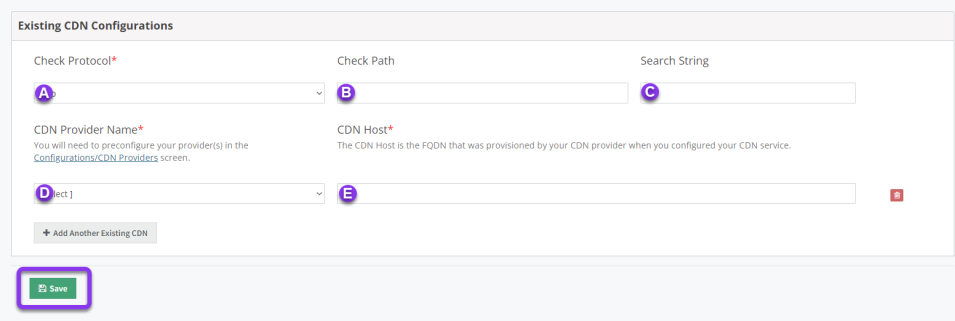
Knowledge Base
How to Configure Multi-CDN (Synthetic)
CDN Provisioning lets you automatically route your web traffic to the fastest CDN provider based on user location. Using Multi-CDN improves speed and uptime, reduces latency, and helps SEO for your domain. Our Multi-CDN tool can be configured to make decisions based on synthetic monitoring or real-user monitoring (RUM). This tutorial walks you through the process of setting up Multi-CDN using synthetic monitoring.
Note: For RUM monitoring, please visit our How to Setup Multi-CDN Using RUM tutorial.
Common Use Case for Multi-CDN Synthetic Monitoring in Constellix
Using synthetic monitoring with your Multi-CDN configuration lets you take advantage of simulated user data collected from data centers and global monitoring nodes. While not based on your exact users like RUM, synthetic monitoring provides valuable insight that you can use to make smarter routing decisions for your domain. This type of monitoring is best for organizations that would like short-term data for troubleshooting performance issues. Synthetic monitoring is also a great solution for smaller businesses, as it allows you to gather data from the Constellix community instead of just the data from users visiting your site.
Prerequisites
- You have already enabled Global Traffic Director (GTD) for your domain
- You have already enabled GeoIP services for your domain
- You have already configured CDNs in your account
How to Setup Multi-CDN With Synthetic Monitoring
1. Navigate to Multi-CDN>Set Up Multi-CDN
Once logged into the Constellix DNS dashboard, click on Multi-CDN in the left-hand menu and then choose the option Set Up Multi-CDN.

2. Create a New Multi-CDN Configuration
You should now be on the Multi-CDN page. Click the green Create new Multi-CDN Configuration button on the right-hand side of the screen.

3. Enter Multi-CDN Information
In the multi-CDN configuration area, fill out the following details:

a) Name: Give your Multi-CDN configuration a memorable name. This is for internal use only and cannot be changed later.
b) Enter a Domain: Enter the name of your virtual host.
c) Choose a source for Traffic Steering decisions: For this tutorial, select Synthetic. With this option, checks are monitored from our nodes across the world.
Note: For help configuring Multi-CDN with RUM checks, visit this tutorial.
d) Automatically Provision CDN Providers: If you are using any of the CDNs we support natively, you can select one or more CDNs and we will configure them for you automatically (must be set up before configuring Multi-CDN).
e) Enter the origin of your data: Enter the address of the web server or website where your files are stored.
4. Configure Existing CDN providers
Fill out the following information to configure your existing CDN providers:

a) Check Protocol: Select the type of Web check: HTTP or HTTPS.
b) Check Path (optional): Enter the path to a file that you would like to check.
c) Search String (optional): Enter the string that is in the first 2KB of
d) CDN Provider Name (must be preconfigured): Click the field to expand options. Select your CDN provider.
Note: To add more CDNs, click the gray + Add Another Existing CDN button.
e) CDN Host: Enter the FQDN supplied by the appropriate CDN provider.
Note: You will only have to enter the FQDN (not the URL) of each CDN in your configuration.
6. Save Multi-CDN Configuration
Once you have entered all necessary information and selected all the appropriate options for your configuration, click the green Save button on the left. Our system will then automatically create Sonar checks and CNAME/ANAME record pools for each GTD region in the account.
Important: In order for your Multi-CDN configuration to take effect, you must apply it to a domain.
Visit our website for more information on our services and features.

